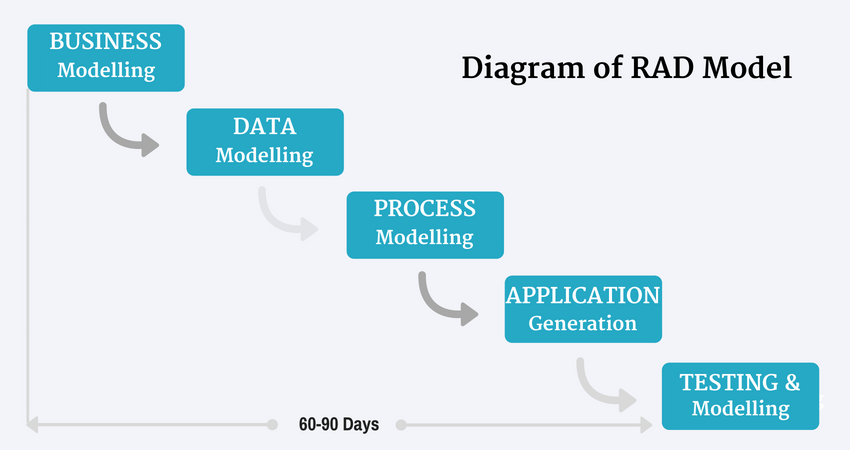Development models have come and gone, but few have persisted as long as the RAD model has. It has entered in some form into every major and minor software player in the market.
But why is it so popular? What makes rapid application development so much better than traditional development models? On the outside, the rapid prototyping and frequent need for communication seem to be more of a drawback than an advantage. So, why has it continued to thrive where so many have failed and died?
What is rapid application development (RAD) model?
RAD is a linear and adaptive software development model based on rapid prototyping with little emphasis on planning. The focus of the RAD Model is to develop software in a short period. In the rapid application development model, prototypes are rapidly churned out and delivered to the client for feedback on future prototypes, where new functions are added.

The RAD model falls into the category of Agile development techniques, which are iterative and incremental methods of software development focused on speed and quick development, more than the long and detailed process that the waterfall model is usually known for.
What are the steps in the RAD model?
Typically, there are four Rapid Application Development phases:
- Plan Requirements
- User Design
- Rapid Construction
- Finalization
Plan Requirements
During this phase, developers and end users get together and find out what the requirements are. This includes project scope, time allocated, and basic functionalities required. It’s not a comprehensive stage since it’s understood that the functionalities will change and evolve as time passes.
User Design
This is where feedback is gathered from the users. While doing so, architecture and design for the product are kept in mind to understand what’s possible and what’s not.
In addition, this feedback from users allows for initial prototypes to be produced quickly. This prototyping step is done as many times as required to finalize all the features and functionalities of the product.
Rapid Construction
After the prototypes in the previous step are confirmed, the features and functions are finalized, and the construction of the final product begins. The construction of the final product is a lot faster than traditional methods since the modules for the decided features were already made in the prototypes. Code reusability is a major factor to consider when following the Rapid Application Development model, since speed and efficiency do matter.
Finalization
This is where the product moves from the building environment to the live environment—from the construction phase to the testing phase. Here, the functions and user interface are tested thoroughly to ensure they all work together without bugs and glitches.
Another part of this step is the training that’s given to end users to ensure that they understand how to use the product, and where they can find what they need.
Example of RAD model
Human Resource apps are a great example of apps that can be built using RAD model tool. The scale and sophistication of a typical HRMS are perfectly suited for the methodology owing to the involvement of the end user. An HRMS developed by RAD can also simplify multiple workflows such as employee onboarding, performance appraisal cycles, and leave management.
These systems get more sophisticated over time and as the organization matures hence RAD can help add functionality as and when required.
When to use the RAD model
RAD is an element-based construction model focusing on quick software application development with no pre-defined planning. A RAD model can be used when:
- The project requires a flexible approach
- Apps need to be developed quicker than usual
- Progress needs to be measurable and visible
- Users are involved in the process end-to-end
- User feedback is readily available
- Technical risk is minimal
- Resources are available to test frequently
What are the advantages of the RAD model?
The RAD model emphasizes changes more than other models. This, and other characteristics give it a number of advantages for Rapid Application Development.
Adaptable to changes
The rapid application development model focuses heavily on ensuring it can change to requirements at the drop of a hat. This gives it a great deal of flexibility when compared to other software development models, like the waterfall model.
Lower chance of errors
Because the RAD framework focuses so much on making as many prototypes as required, this ensures that each and every function and feature is built completely, giving them the required attention. This allows for the product to have fewer defects and bugs, due to an emphasis on reusing code and using code generators.
Higher productivity with a small team
Rapid application development is optimized for a small team with effective communication. If you’ve got that, then adapting rapid application development methodology helps increase overall team productivity, since there’s frequent communication about what each person is doing to bring the project to completion.
Drawbacks of Rapid Application Development Model
Rapid Application Development isn’t without its own set of drawbacks. Some of them include:
- Not all applications can be built using this method
- Requires a high commitment from developers and clients
- Complexity and sophistication change on a daily basis
- Can be difficult to focus on deadlines in favor of adding functionality
- Not suited for high risk and priority projects
- Requires time to scale to its full potential
- Requires a set of highly skilled developers and testers
How Kissflow uses the RAD model
With Kissflow, you can create your own custom apps for your business processes and workflows. All you need is the logic of how your process works, and you can get started on building your app.
There’s very little, if any, coding required here.
But how does Kissflow use a rapid application development model to develop their apps?
The rapid application development model emphasizes rapid prototyping, and Kissflow does the same. Developing your app quickly, through several iterations, to figure out the functionality that you want from it, and making adjustments with each iteration, is where Kissflow uses the rapid application development model.
For example, if you’re looking into developing an app on Kissflow for some use case, say to manage your finance department, you’ll have a basic idea of what your finance department needs. Using rapid prototyping, you can make several models and get feedback from the finance team on what they’re looking for.
Once you have a prototype that has all the features that they’re looking for, you can develop the final app, and launch it.
This is one of the advantages of using the Rapid Application Development platform. The rapid application development phases are designed to encourage numerous changes to the design and development so that there’s more action than guesswork and deliberation.
Conclusion
Kissflow employs a lot of RAD design philosophies, such as quick prototyping, receiving constant feedback on how an app works, and easy maintenance. This provides you with a platform to create apps quickly. Moreover, since you can test it out before you release it into your office environment, you have an idea of whether it actually works as intended or not.
If it doesn’t, you can go back to the design stage and figure out what went wrong, all without risking office productivity.



